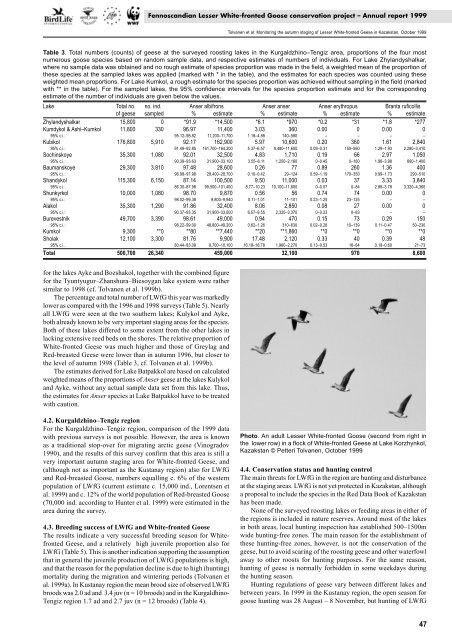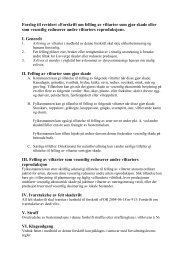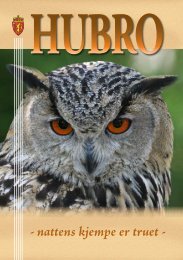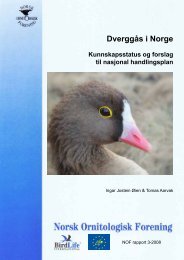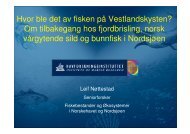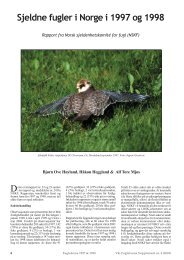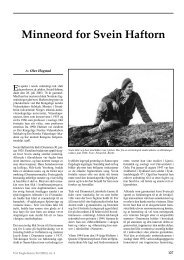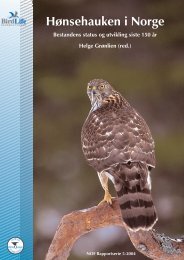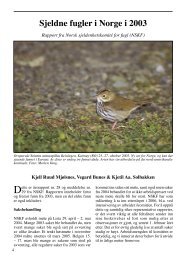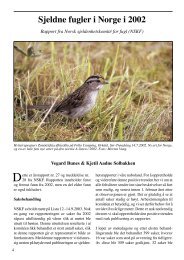Fennoscandian Lesser White-fronted Goose conservation project ...
Fennoscandian Lesser White-fronted Goose conservation project ...
Fennoscandian Lesser White-fronted Goose conservation project ...
Create successful ePaper yourself
Turn your PDF publications into a flip-book with our unique Google optimized e-Paper software.
<strong>Fennoscandian</strong> <strong>Lesser</strong> <strong>White</strong>-<strong>fronted</strong> <strong>Goose</strong> <strong>conservation</strong> <strong>project</strong> – Annual report 1999<br />
Table 3. Total numbers (counts) of geese at the surveyed roosting lakes in the Kurgaldzhino–Tengiz area, proportions of the four most<br />
numerous goose species based on random sample data, and respective estimates of numbers of individuals. For Lake Zhylandyshalkar,<br />
where no sample data was obtained and no rough estimate of species proportion was made in the field, a weighted mean of the proportion of<br />
these species at the sampled lakes was applied (marked with * in the table), and the estimates for each species was counted using these<br />
weighted mean proportions. For Lake Kumkol, a rough estimate for the species proportion was achieved without sampling in the field (marked<br />
with ** in the table). For the sampled lakes, the 95% confidence intervals for the species proportion estimate and for the corresponding<br />
estimate of the number of individuals are given below the values.<br />
Lake Total no. no. ind. Anser albifrons Anser anser Anser erythropus Branta ruficollis<br />
of geese sampled % estimate % estimate % estimate % estimate<br />
Zhylandyshalkar 15,800 0 *91.9 *14,500 *6.1 *970 *0.2 *31 *1.8 *277<br />
Kumdykol & Ashi–Kumkol 11,800 330 96.97 11,400 3.03 360 0.00 0 0.00 0<br />
:95% c.i.: 95.12–98.82 11,200–11,700 1.18–4.88 140–580 – – – –<br />
Kubikol 176,800 5,910 92.17 162,900 5.97 10,600 0.20 360 1.61 2,840<br />
:95% c.i.: 91.49–92.85 161,700–164,200 5.37–6.57 9,480–11,600 0.09–0.31 150–560 1.29–1.93 2,280–3,410<br />
Sochinskoye 35,300 1,080 92.01 32,500 4.83 1,710 0.19 66 2.97 1,050<br />
:95% c.i.: 90.39–93.63 31,900–33,100 3.55–6.11 1,250–2,160 0–0.45 0–160 1.96–3.98 690–1,400<br />
Baumanskoye 29,300 3,810 97.48 28,600 0.26 77 0.89 260 1.36 400<br />
:95% c.i.: 96.98–97.98 28,400–28,700 0.10–0.42 29–124 0.59–1.19 170–350 0.99–1.73 290–510<br />
Shandykol 115,300 6,150 87.14 100,500 9.50 11,000 0.03 37 3.33 3,840<br />
:95% c.i.: 86.30–87.98 99,500–101,400 8.77–10.23 10,100–11,800 0–0.07 0–84 2.88–3.78 3,320–4,360<br />
Shunkyrkol 10,000 1,080 98.70 9,870 0.56 56 0.74 74 0.00 0<br />
:95% c.i.: 98.02–99,38 9,800–9,940 0.11–1.01 11–101 0.23–1.25 23–125 – –<br />
Alakol 35,300 1,290 91.86 32,400 8.06 2,850 0.08 27 0.00 0<br />
:95% c.i.: 90.37–93.35 31,900–33,000 6.57–9.55 2,320–3,370 0–0.23 0–83 – –<br />
Burevestnik 49,700 3,390 98.61 49,000 0.94 470 0.15 73 0.29 150<br />
:95% c.i.: 98.22–99.00 48,800–49,200 0.62–1.26 310–630 0.02–0.28 10–139 0.11–0.47 50–230<br />
Kumkol 9,300 **0 **80 **7,440 **20 **1,860 **0 **0 **0 **0<br />
Sholak 12,100 3,300 81.76 9,900 17.48 2,120 0.33 40 0.39 48<br />
:95% c.i.. 80.44–83.08 9,700–10,100 16.18–18.78 1,960–2,270 0.13–0.53 16–64 0.18–0.60 21–73<br />
Total 500,700 26,340 459,000 32,100 970 8,600<br />
for the lakes Ayke and Bozshakol, together with the combined figure<br />
for the Tyuntyugur–Zhanshura–Biesoygan lake system were rather<br />
similar to 1998 (cf. Tolvanen et al. 1999b).<br />
The percentage and total number of LWfG this year was markedly<br />
lower as compared with the 1996 and 1998 surveys (Table 5). Nearly<br />
all LWfG were seen at the two southern lakes; Kulykol and Ayke,<br />
both already known to be very important staging areas for the species.<br />
Both of these lakes differed to some extent from the other lakes in<br />
lacking extensive reed beds on the shores. The relative proportion of<br />
<strong>White</strong>-<strong>fronted</strong> Geese was much higher and those of Greylag and<br />
Red-breasted Geese were lower than in autumn 1996, but closer to<br />
the level of autumn 1998 (Table 3, cf. Tolvanen et al. 1999b).<br />
The estimates derived for Lake Batpakkol are based on calculated<br />
weighted means of the proportions of Anser geese at the lakes Kulykol<br />
and Ayke, without any actual sample data set from this lake. Thus,<br />
the estimates for Anser species at Lake Batpakkol have to be treated<br />
with caution.<br />
4.2. Kurgaldzhino–Tengiz region<br />
For the Kurgaldzhino–Tengiz region, comparison of the 1999 data<br />
with previous surveys is not possible. However, the area is known<br />
as a traditional stop-over for migrating arctic geese (Vinogradov<br />
1990), and the results of this survey confirm that this area is still a<br />
very important autumn staging area for <strong>White</strong>-<strong>fronted</strong> Geese, and<br />
(although not as important as the Kustanay region) also for LWfG<br />
and Red-breasted <strong>Goose</strong>, numbers equalling c. 6% of the western<br />
population of LWfG (current estimate c. 15,000 ind., Lorentsen et<br />
al. 1999) and c. 12% of the world population of Red-breasted <strong>Goose</strong><br />
(70,000 ind. according to Hunter et al. 1999) were estimated in the<br />
area during the survey.<br />
4.3. Breeding success of LWfG and <strong>White</strong>-<strong>fronted</strong> <strong>Goose</strong><br />
The results indicate a very successful breeding season for <strong>White</strong><strong>fronted</strong><br />
Geese, and a relatively high juvenile proportion also for<br />
LWfG (Table 5). This is another indication supporting the assumption<br />
that in general the juvenile production of LWfG populations is high,<br />
and that the reason for the population decline is due to high (hunting)<br />
mortality during the migration and wintering periods (Tolvanen et<br />
al. 1999a). In Kustanay region the mean brood size of observed LWfG<br />
broods was 2.0 ad and 3.4 juv (n = 10 broods) and in the Kurgaldhino-<br />
Tengiz region 1.7 ad and 2.7 juv (n = 12 broods) (Table 4).<br />
Tolvanen et al: Monitoring the autumn staging of <strong>Lesser</strong> <strong>White</strong>-<strong>fronted</strong> Geese in Kazakstan, October 1999<br />
Photo. An adult <strong>Lesser</strong> <strong>White</strong>-<strong>fronted</strong> <strong>Goose</strong> (second from right in<br />
the lower row) in a flock of <strong>White</strong>-<strong>fronted</strong> Geese at Lake Korzhynkol,<br />
Kazakstan © Petteri Tolvanen, October 1999<br />
4.4. Conservation status and hunting control<br />
The main threats for LWfG in the region are hunting and disturbance<br />
at the staging areas. LWfG is not yet protected in Kazakstan, although<br />
a proposal to include the species in the Red Data Book of Kazakstan<br />
has been made.<br />
None of the surveyed roosting lakes or feeding areas in either of<br />
the regions is included in nature reserves. Around most of the lakes<br />
in both areas, local hunting inspection has established 500–1500m<br />
wide hunting-free zones. The main reason for the establishment of<br />
these hunting-free zones, however, is not the <strong>conservation</strong> of the<br />
geese, but to avoid scaring of the roosting geese and other waterfowl<br />
away to other roosts for hunting purposes. For the same reason,<br />
hunting of geese is normally forbidden in some weekdays during<br />
the hunting season.<br />
Hunting regulations of geese vary between different lakes and<br />
between years. In 1999 in the Kustanay region, the open season for<br />
goose hunting was 28 August – 8 November, but hunting of LWfG<br />
47


